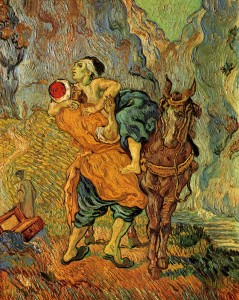 We hear the parable of the Good Samaritan so much that it’s hard to be impacted by it. And if we are impacted by it, it’s often to become more like the Samaritan — an admirable goal and one I’d in no way want to discourage!
We hear the parable of the Good Samaritan so much that it’s hard to be impacted by it. And if we are impacted by it, it’s often to become more like the Samaritan — an admirable goal and one I’d in no way want to discourage!
But is this all Jesus was wanting to say?
The story ends with the command to “go and do likewise”. Be a neighbour by showing mercy.
Simple.
Only thing is, the one who showed mercy was quite surprising. This was a Samaritan, an outsider, deeply suspicious and certainly not to be trusted.
I wonder who would be treated similarly today? A Muslim refugee? A young homosexual man? A North Korean communist? Would we be more impacted I wonder if the parable was rewritten with a Muslim showing compassion and mercy?
Kim Fabricius has written this fantastic paraphrase of the story.
It strikes me that almost in the same sentence, we can proclaim God’s love and then go on to show remarkable intolerance for people different from us. We will love them (as long as they become like us).
But that’s not the point of the parable is it? The whole point is that the Samaritan shows mercy even though the beaten up man is not like him. And it’s the Samaritan, not the Jew that shows it.
That should certainly give us pause in our assumption that Christians have a monopoly on love and mercy.
…
I wonder if another reading of the parable would come in handy. For Christians that often assume that we are the good Samaritan, what would it mean for us to see ourselves as the beaten up person?
Some art historians think that Vincent van Gogh did. Check out his rendition of the Good Samaritan:
 It’s an exact mirror image of one by Eugene Delacroix (seen above). Because the painting is mirrored, it means the man’s left ear is visible and bandaged. This was the ear that van Gogh famously sliced off. Van Gogh painted this while in a mental asylum in St. Remy (perhaps not a dissimilar environment to the beaten man recovering from his wounds).
It’s an exact mirror image of one by Eugene Delacroix (seen above). Because the painting is mirrored, it means the man’s left ear is visible and bandaged. This was the ear that van Gogh famously sliced off. Van Gogh painted this while in a mental asylum in St. Remy (perhaps not a dissimilar environment to the beaten man recovering from his wounds).
While the Levite and priest are almost like lifeless dolls walking off into the distance, the Samaritan and the beaten man are painted in vivid colours including blue which often represents the divine. Van Gogh is indicating there is something of the divine in this act of mercy.
It is interesting that both the Samaritan and the beaten man are dressed in blue. Why not just the Samaritan showing the mercy?
Perhaps it is because love and compassion is equally something to receive as it is to give. Part of truly loving someone is learning to receive, learning to trust, learning to be loved. Any meaningful relationship involves becoming vulnerable to the other person, trusting them to build you up and honour your deepest insecurities.
To truly love means to become vulnerable and dependent on the other.
Even in God’s very being we see this relationship of vulnerability and dependence. God is Father-Son-Spirit, eternally giving, eternally receiving, eternally depending on each person of the Godhead.
I wonder if we need to become vulnerable to the other, to the Muslim, the homosexual, the communist. What would it mean to receive love and welcome from them rather than arrogantly assuming the Church is only group with anything to give?
Let us know your thoughts!
Arohanui,
Jordan

2 comments for “The Parable of the Good Muslim”